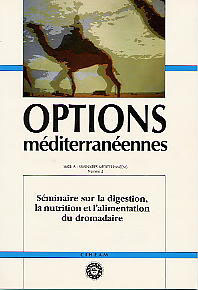| Article précédent | p. 61-65 | Article suivant |
Problème de la détermination de la valeur alimentaire des fourrages prélevés par le dromadaire
The dromedary is well adapted to the utilisation of ligneous vegetation of low nutritional value found in its natural habitat zone, thanks to its aptitude to vary its food, and to search for foods that are rich in water content and that can make up for its nutritional deficits, particularly as concerns mineral elements. However, we lack sufficient precise information as to the real composition of the ingested ration, and on the intensity of its breakdown, particularly through microbial digestion in the stomachal pockets and in the large intestine. We do not know which modifications could be introduced in the ingestion and the digestion of fodder during non-watering periods. That is why it appears advisable to propose a co-ordinated research plan on the dromedary's nutritional behaviour and digestion, through the use of chemical analysis techniques and techniques for the analysis of in vitro breakdown, completed by a careful use of fistulated animals. Comparisons could judiciously be drawn with caprines.
- [ Afficher ]
- [ Télécharger ]
- [ Exporter la citation ]
Vous pouvez télécharger la citation au format :
- [ Imprimer ]
-
Mots-clés
DIGESTION, DROMADAIRE, PLANTE FOURRAGERE, PRISE ALIMENTAIRE (ANIMAUX)Citer cet article
Faye B., Tisserand J.-L. Problème de la détermination de la valeur alimentaire des fourrages prélevés par le dromadaire. In : Tisserand J.-L. (ed.). Séminaire sur la digestion, la nutrition et l'alimentation du dromadaire. Zaragoza : CIHEAM, 1989. p. 61-65. (Options Méditerranéennes : Série A. Séminaires Méditerranéens; n. 2). Séminaire sur la Digestion, la Nutrition et l'Alimentation du Dromadaire, 1988/02/27-1988/03/01, Ouargla (Algeria). http://om.ciheam.org/om/pdf/a02/CI000428.pdf



